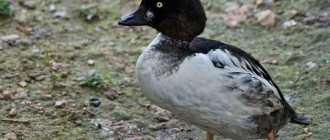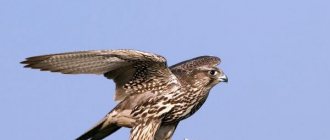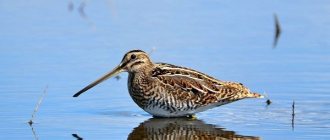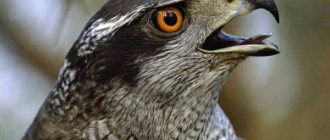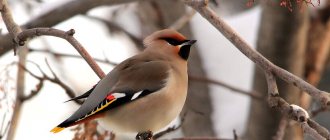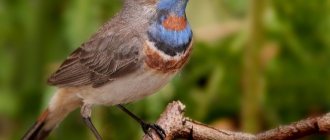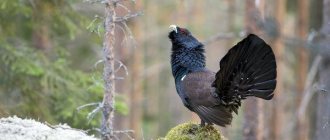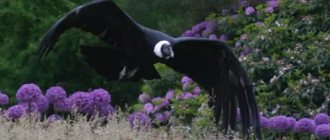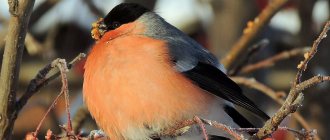Scientific classification
- Kingdom: Animalia (animals)
- Phylum: Chordata
- Class: Aves (birds)
- Order: Accipitriformes (Accipitriformes)
- Family: Pandionidae (ospreys)
- Genus and species: Pandion haliaetus (osprey)
The osprey is the only species in the family Pandionidae, which is sometimes considered a subfamily (Pandioninae) of the hawk-eagle family (Accipitridae).
Other names: fishing hawk, great long-winged hawk
Varieties
There are four subspecies of osprey, which are separated by geographic region:
- Pandion haliaetus carolinensis - lives in North America and the Caribbean, but winters in South America;
- Pandion haliaetus haliaetus - found in the Palearctic (Europe, North Africa and Asia, north of the Himalayas), but winters in South Africa, India and the East Indies;
- Pandion haliaetus ridgwayi is a non-migratory subspecies. It lives in the Caribbean, and its range extends from the Bahamas and Cuba to southeastern Mexico and Belize.
- Pandion haliaetus leucocephalus is a sedentary subspecies. Its range includes Australia and the southwest Pacific.
LIFESTYLE
The osprey is the only representative of the osprey family. This bird is very elegant. Distinctive features of the osprey are a small, stocky body, a short, hooked, curved beak, strong legs, the unfeathered part of which is covered with thick but small mesh scales. The long wings of the osprey have a characteristic kink and resemble the letter “M”. The osprey has an almost cosmopolitan distribution. It nests in Europe, North America, Asia, Australia and North Africa. In winter, the osprey moves from the northern regions to places with a milder climate. Birds that nest in Europe go to warmer climes in Africa, and their relatives from North America look for places suitable for them in Central and South America.
Spread range
Geographical distribution
The osprey is a cosmopolitan bird species found on every continent except Antarctica. They do not breed in South America or the Indo-Malayan region, but are sometimes found there in winter. Ospreys nest in Egypt and on a number of Red Sea islands in winter. Regions where these birds are particularly abundant include Scandinavia and the Chesapeake Bay region of the United States.
Photo: Wikipedia
Habitat
Osprey is one of the most common birds in the world . It is found on ocean coasts and along the shorelines of large lakes and rivers on all continents and islands, with the exception of polar and subpolar regions where water surfaces are frozen for most of the year, and a few very isolated islands in temperate and tropical climates.
These birds of prey can live almost anywhere where there are safe nesting sites and shallow waters with an abundance of fish. Nests are usually within 3–5 km of a body of water , such as a salt marsh, mangrove or cypress swamp, lake, reservoir or river. The frequency of use of each of these habitat types depends on the geographic region.
Photo: Karo Kujanpaa
Ospreys choose structures that can support a bulky nest and are protected from ground-based predators. The nest may be established over water (buoys, channel markers, fallen trees and artificial nest sites) or on a small island. Ospreys are also known to nest on a variety of man-made structures such as power poles, communication towers, buildings and even billboards. In many cases, nests built on artificial structures are more stable and produce more chicks per breeding season than nests on natural structures.
- Habitat: temperate, tropical
- Terrestrial biomes: forest, rainforest, mountains, suburbs, coastal
- Aquatic biomes: lakes and ponds, rivers and streams, wetlands, marine coastal waters
Home range
Photo: Joshua J. Cotten
Nesting ospreys are known to move up to 14 km from their nest during hunting raids. Non-breeding individuals travel up to 10 km between their daily feeding sites and shelters.
Where does the osprey live?
Photo: Osprey in flight
The range of the osprey with all its subspecies covers the temperate, subtropical and tropical climate zones of Eurasia, Africa, the Americas, as well as Australia and Oceania. The birds are distributed unevenly throughout their range; they are found quite rarely and scattered. Desert and high mountain areas are avoided.
It is possible to identify areas of the range where:
- migratory birds nest;
- resident ospreys live;
- migratory birds are encountered during seasonal migrations;
- migrants from the north spend the winter.
On Russian territory, the northern border of the range approximately coincides with 67° N latitude. in the European part, then passes along latitude 66° in the Ob basin, to the east it moves even further south: to the mouth of the river. Lower Tunguska, lower reaches of Vilyuy, lower reaches of Aldan. Along the Okhotsk coast it runs north of Magadan to Kamchatka. The southern border in the European part runs in the lower reaches of the Don and the Volga delta. In Siberia and the Far East, the osprey can be found right up to the southern border of the country.
In Russia, the predator often chooses the banks of reservoirs as a place of residence, surrounded by old trees (pines) with withered tops. Loves swampy sparse forests and vast lakes with clean, shallow water, rivers with riffles and reaches. Does not shy away from sea coasts and islands. Nesting sites are mainly limited to the forest zone, although birds can also settle outside it - in the floodplain forests of the steppes. On migration they can be found in open steppe areas. In southern treeless areas, sedentary ospreys build nests on the cliffs of sea coasts, on coastal islands and even in small coastal towns.
Now you know where the osprey fisherman lives. Let's see what he eats.
Character traits
Appearance
Adult birds have a dark brown back and a bright white forehead, cheeks, neck, chest and belly. A dark stripe runs from the base of the beak and through the eye to the back. The head and upper chest are streaked with brown , as are the undersides of the wings and tail. There are dark brown spots on the wrist knuckles. The legs of this species are pale gray and the bill is black.
Photo: Karo Kujanpaa
Juveniles and adults are very similar; however, juveniles have brown upperparts feathers that are tipped with white, and the chest and head have more striped plumage. Ospreys acquire their adult plumage at approximately 18 months.
Anatomical features
Anatomically, the osprey is similar to an eagle, but its narrow, long wings have a characteristic curve at the carpal joints, and the structure of the paws and claws is so unique that the osprey has been placed in a separate subfamily Pandioninae.
Unlike other birds of prey, the osprey has four toes of equal length . A long, sharp, curved claw on each toe, a double-sided outer toe, and short, stiff spines on the soles of each foot allow the bird to hold a firm grip on slippery live fish.
Photo: nickmandalou
In addition, ospreys have dense, oily plumage and effective nasal valves that prevent water from entering the nostrils when diving into the water.
Dimensions
Ospreys are large birds of prey with a wingspan of 145 to 170 cm. As is the case with most birds of prey, the female is 20% heavier than the male and has a wingspan 5-10% larger. She weighs on average 1.6 kg compared to the male's 1.4 kg, and has an average wingspan of 163 cm compared to the male's 159 cm. An adult has a body length of 53 to 58 cm.
Ospreys show morphological variations across regions as well. Tropical and subtropical individuals tend to be smaller than individuals breeding at higher latitudes. The four subspecies of osprey also vary in size. Pandion haliaetis haliaetus and Pandion haliaetis carolinensis are the largest subspecies, and Pandion haliaetis cristatus is the smallest subspecies.
- Body weight: from 1.2 to 2 kg
- Body length: 53 to 58 cm
- Wingspan: from 145 to 170 cm
CHARACTERISTIC FEATURES OF THE OSCOPY. DESCRIPTION
Eggs: white with black or brown spots, the female osprey lays 2-3, less often - 4 eggs.
Nest: located high in the crowns of huge trees or on rocks.
Chicks: fed by the female. They begin to fly at the age of 50-60 days.
Distinctive features: brown plumage. The head is white, with a dark stripe running down from the eye to the middle of the neck. The wings are unusually long. Legs are strong, not fully feathered.
— All year — Wintering — Nesting
WHERE DOES IT LIVE?
Osprey is found on almost the entire sea coast and near fresh water bodies. The map shows the places where it winters and nests, as well as those places where it lives throughout the year.
PROTECTION AND PRESERVATION
In many places the osprey has become a rare species. The use of pesticides in agriculture and hunting has led to a decline in the number of this bird.
Behavior and lifestyle
Photo: dplawrance
Ospreys can lead migratory and sedentary lifestyles . Non-migratory populations breed and overwinter in the same location. Migratory bird populations typically breed north of non-migratory populations and winter south of them, with very little overlap between the two groups. The geographic separation between migratory and non-migratory populations is approximately 30 degrees north latitude in North America and 38-40 degrees north latitude in Europe.
Ospreys nest in varying densities , from very solitary nests (many kilometers from the nearest nest) to loose colonies with nests less than 100 meters apart. Colonies often form because the presence of already established nests signals suitable habitat for arriving individuals.
Photo: jdlacy
Colony formation is not common for predatory species because most predators defend a feeding territory around their nest. Ospreys defend the nesting site, but do not defend the area around the nest. It is disadvantageous for the pair to defend the territory around the nest because their prey is unevenly distributed, mobile, and often located several kilometers from the nest.
Ospreys fiercely defend their nesting sites from intruders. Most likely, this is due to the fact that the nests are used by the same couple for many years, and their arrangement requires a significant investment of time and energy for the couple.
Osprey attacks. Video (00:00:58)
Looking into an osprey's nest is a very difficult task: the nests are high and at the very top of the tree. There was nothing to hold onto there, the branches were falling off the nest, and in one hand I still had a huge shoulder-mounted camera... And once, at the height of a five-story building, I lifted the camera into the nest on a heavy tripod at random, holding it by the tip with one hand. It would be worth slightly deflecting this thing from the vertical and all the equipment would fly down and break into pieces. Miraculously he held on. And this nest is one of the few that you can look into. I actually climbed one nesting tree - and turned back halfway - it was so dry that the entire upper part could fall off...
Communication and perception
Photo: Jongsun Lee
These birds of prey use several different vocalizations to communicate with each other. The researchers identified up to five different calls. These calls are almost always associated with a visual display, such as a characteristic flight or posture adopted.
a weak voice for its size , but if it feels threatened, its cry carries a fair distance. Vocalizations are also used for begging, courtship, and nest defense.
One notable means of communication is the "sky dance" , which is an elaborate aerial display performed by males during courtship and early incubation. During this display, the male, carrying fish or nesting material, emits a call while performing short, undulating flights, separated by periodic hovering.
Eating habits
Diet
Photo: Zach Baranowski
Ospreys are unusual raptors because they are fish-eating birds . Their diet consists almost exclusively of fish (≥99% of prey). They are generally opportunistic and will eat any fish species available to them in shallow water or near the surface of deeper waters. Favorite freshwater species are pike and perch; but in salt water the osprey prefers to hunt flounder, trout, pollock and smelt.
Most of the fish caught weigh between 150 and 300 grams and are about 25-35 cm long, although some specimens reach 2 kg.
Sometimes ospreys eat other foods: birds, snakes, voles, squirrels, muskrats, salamanders and even small alligators. Reports of feeding on carrion are rare. However, ospreys have been observed eating dead white-tailed deer and opossum.
Hunting technique
Photo: jdlacy
Each day, the osprey makes several patrols over large expanses of water in its territory that offer the best hunting opportunities. When the bird sees a fish, it hovers at a height of 10 to 30 meters until the prey is in a suitable position.
Catching success varies from 24 to 74%. This indicator is influenced by individual ability, weather and tide. Ospreys are most successful at mid-low tide and in calm weather.
The huge but surprisingly light osprey flaps and bends its wings back just before diving, plunging into the water feet first. Osprey lifts itself and its prey out of the water with strong, almost horizontal flapping of its wings. If the fish is large or difficult to control, the bird may have to make several attempts before it manages to get out of the water. It happened that an osprey, having caught a fish that was too large, could not loosen its grip, and the prey dragged it under the water, where the bird drowned. Ospreys sometimes catch fish by skimming the surface of the water and snatching up dead or dying fish.
Photo: Keith Luke
The osprey carries its catch head first , holding all but the smallest fish with both legs. Sometimes a bald eagle will try to rob an osprey by chasing it in flight until it drops its prey. Except during the nesting season, the osprey sits near the fishing site to eat its catch, which it holds with one leg and tears into pieces with its beak, devouring the head first. During the nesting period, the bird carries its prey to the nest or to the nearest place from the perch.
Ospreys generally do not need to drink water. Fish meat provides enough water to meet their needs.
INTERESTING FACTS, INFORMATION…
- The osprey is an extremely agile hunter and can often catch two fish at once.
- The sounds that the osprey makes consist of high-pitched whistling tones.
- The osprey's outermost toe can rotate back and forth, allowing the bird to firmly hold its prey.
- In the old literature, stories about the death of ospreys pulled under water by pikes were popular, but in the scientific literature there are no reliably described cases of this kind.
- Gardners Island near New York City was once home to a colony of ospreys numbering more than 300 pairs.
Reproduction
Courtship ritual
At the beginning of the breeding season, when ospreys pair up or confirm a previously formed bond, they display a spectacular display . The male repeatedly flies high into the air, hovers for a few seconds, dives and rises again in a wide arc. Sometimes the female engages in a modified version of this display, displaying pursuit of the male.
Photo: Ralph Mayhew
In another type of ritual display near the nest, the male flies studiously with his body arched and his legs dangling below, often holding a fish or branch in his talons.
Breeding season
Ospreys become sexually mature by age three , but cannot breed until age 5 in areas where nesting sites are scarce. The most recorded number of breeding seasons for a single bird is 23.
The breeding season of ospreys varies among different populations. Non-migratory populations breed in winter and spring, laying eggs from December to March. The breeding season of migratory populations occurs in spring and summer, and egg laying occurs in April and May.
Photo: Troy Harrison
Ospreys are usually monogamous . However, polygamy can occur in rare cases when nesting sites are close enough to each other for the male to defend two nests. When this happens, the first nest usually has higher reproductive success than the second because the male is devoting more resources to that nest.
- Breeding interval: once a year
- Breeding season duration: 2.5 to 4 months
Nesting
Single large nests or colonies are built on the tops of tall trees, small islands or rock ledges. The tree can be living or dried, but it is desirable that it be strong enough to support the weight of the nest, which consists of a huge mass of dead branches intertwined with other materials such as stakes, rope, strips of old fabric, plastic and even caribou antlers.
Photo: Andy Nguyen
Both sexes collect materials for the nest, but the female does most of the nesting. To build their nest, birds collect branches from the ground or break them from trees. The inside of the nest is lined with softer materials such as algae, grass or cardboard. Most construction occurs early in the nesting season. At the end of summer, the bird spends a lot of time repairing the nest in order to use it next year.
On average, the nests are between 30 and 60 cm deep and 1 meter in diameter, but some are over 2.5 meters in diameter . As nesting season progresses, the nest becomes flatter. Each year the osprey adds materials, and the resulting enormous weight of the nest sometimes causes it to slide down the tree trunk.
Photo: Index Open
The osprey usually defends its territory from other large birds such as eagles, owls, gulls and great blue herons, which will not hesitate to invade its nest. The osprey often takes the precaution of building more than one nest in its territory, especially if it fails to produce chicks during the year.
Chick development
Nesting females lay an average of three eggs, which are yellowish-brown with dark brown speckles. Because incubation begins when the first egg is laid, the eggs hatch asynchronously in the order in which they were laid. The chicks that hatch first are larger and have a competitive advantage over other chicks. If food becomes scarce, smaller chicks are less successful in competing for food and often die. Reducing the number of chicks in a nest makes food more available to the surviving chicks and increases their likelihood of survival. This process, common in birds of prey, is called "brood reduction" .
Photo: Daily Record
Osprey chicks, when hatching, are covered with white down with brown streaks on their face, back and wings. After about 10 days it is replaced by charcoal-colored fluff. Feathers begin to replace down after about two weeks. One month after hatching, the chicks reach 70 to 80% adult size. Osprey chicks fledge between 48 and 76 days old. Typically, chicks in migratory populations fledge earlier than those in sedentary populations.
The male has little involvement in incubating or heating the eggs until they hatch and devotes most of his time to fishing. He is the sole breadwinner for the family during the month of incubation and the subsequent month when the growing chicks require more than six fish per day . If food is plentiful, two out of three chicks can usually fly after seven to nine weeks of constant parental care.
Photo: Earth Touch News
After fledging, young ospreys begin hunting on their own. However, they often continue to return to the nest to obtain food from their parents for two to eight weeks after fledging.
- Range of eggs per season: 1 to 4 eggs
- Incubation period: 32 to 43 days
Social structure and reproduction
Photo: Osprey pair
In different parts of the vast range, the mating season begins at different times. Residential birds begin building nests in December-March, migratory birds - in April-May. Ospreys each fly to their nesting sites on their own, although they are monogamous and maintain permanent pairs for many years. Males arrive first, females arrive a few days later.
In the forest zone, ospreys make nests on the dry tops of large trees, on the supports of high-voltage lines, towers for various purposes, and artificial platforms that are offered to them by conservationists. When choosing a place, ensure the proximity of a good body of water, so that it is no further than 3-5 km. Sometimes they build nests above the water.
The distance between nests ranges from 100 m to several kilometers. Typically, each family settles away from the others, but colonies form near especially fishy bodies of water. The nest is made of twigs, the finishing is done with algae or grass, moss - whatever you can find. Sometimes there is fishing line or plastic bags. The nests serve one permanent pair for many years, each season they are renewed and completed.
Before marriage, the male displays, flying in circles over the nest where the female sits. Emits a series of screams, flies up, flutters its wings and holds a gift fish in its paw. About 10 minutes later, deciding that he has tried hard enough, he flies to his lady’s nest. When the wife begins to incubate the eggs, the male brings her food and can take part in the incubation. Adultery occurs when the male does not bring enough food and the hungry female is forced to turn to others. Or the male begins to work for two families if the nests are located nearby.
There are from 2 to 4 eggs, the color is white with brown speckles. The chicks are born after 38–41 days. If there is a lack of food, not all chicks survive, but only those that hatched first. The female warms them constantly for two weeks, then less often, devoting time to getting food. The young fledge after 1.5 - 2.5 months and can hunt independently, although they still try to beg food from their parents for a long time. Each one flies to the winter on his own. Ospreys become sexually mature by the age of 3-5 years and spend their youth “abroad” - in wintering areas.
Interesting fact: nests have been recorded in Australia that have been in use for 70 years. They are located on coastal rocks and are huge piles of driftwood and branches entwined with algae, reaching 2 m in height, 2 m in width and weighing 135 kg.
Lifespan and predation
Ospreys are relatively long-lived bird species . Available banding data indicate that ospreys live between 15 and 20 years. The longevity record for this species belongs to a bird that died from a bullet at the age of 35. Recent estimates suggest that about half of young ospreys die in their first year of life; the mortality rate in subsequent years ranges from 16 to 19%.
Ospreys are vulnerable to aerial predators such as great horned owls, eagles and bald eagles. Raccoons, snakes and other rock animals steal osprey eggs and chicks. In Africa, Nile crocodiles sometimes kill birds swimming and resting near the water.
Natural enemies
In North America, osprey chicks and, less commonly, adults are hunted by the great eagle owl and the bald eagle. The following are also recognized as natural enemies of ospreys:
- eagles and owls;
- raccoons and martens (destroy nests);
- cats and snakes (destroy nests).
Birds wintering in hot countries are attacked by some species of crocodiles, in particular the Nile: it grabs an osprey diving for fish.
Return to content
Interspecies interactions
Although ospreys provide food for some species of predator, it is unlikely that they constitute a significant portion of any species' diet. Ospreys do hunt fish and likely have some impact on local fish populations. Like most predators, ospreys are host to many different types of parasites, including feather mites.
Osprey nests are used by many species of birds. Smaller nesting species such as common grackles, tree and barn swallows, European starlings and sparrows will build nests inside osprey nests. Other larger species will occupy osprey nests for their own use in the spring before they return. This includes great blue herons, Canada geese, bald eagles, red-tailed hawks, great horned owls, herring gulls and common ravens.
Ospreys in some areas, especially boreal and other boreal forest regions, may have historically depended on beavers for habitat creation. Beavers, when building dams, create shallow ponds for fishing and cut down trees suitable for building bird nesting areas.
Population and species status
The International Union for Conservation of Nature has designated the osprey as a species of Least Concern (LC), saying its global population is increasing. However, Pandion haliaetus is currently included in several conservation documents, such as:
- Annex II of the Berne Convention;
- Annex I of the EU Rare Birds Directive;
- Annex II of the Bonn Convention;
- Red Data Books of Lithuania, Latvia and Poland;
- Red Books of Russia, Ukraine and Belarus.
In the Red Book of Belarus, the osprey is listed in category II (EN), which unites taxa that are not threatened with extinction in the country, but have an unfavorable European/international conservation status or a forecast for its deterioration.
In those regions where the osprey population is declining, this is due to poaching, poisoning with pesticides and destruction of the food supply.
The current population of osprey in the Russian Federation is approximately 10 thousand breeding pairs. In Europe and North America, the osprey population is being restored thanks to conservation measures and attracting birds to artificial nesting sites.
Return to content
Meaning to people
Ospreys can be a valuable indicator species for long-term monitoring of the health of large rivers, bays and estuaries. Ospreys are well suited to this role due to their piscivorous lifestyle and known sensitivity to many pollutants. They are also relatively easy to study because they have visible nests and are tolerant of short-term disturbances, such as nest observations by researchers. The presence of ospreys may also benefit the local economy through the development of ecotourism.
Save Status
Ospreys are not listed on the IUCN Red List. However, like many other birds of prey high on the food chain, ospreys around the world had problems breeding in the 1950s and 1960s. These problems have arisen mainly due to the widespread use of organochlorine pesticides , which cause thinning of the eggshells, which, as a consequence, tend to break under the weight of the female. Since the use of these products has been restricted almost everywhere, populations in areas where there is still suitable habitat for the species have begun to recover.
The bird's amazing adaptability, which allows it to live close to people and use artificial structures for nesting, supported by access to artificial water bodies and fish ponds, has also helped restore osprey populations that were hit hardest by pesticides.
Number
Osprey bird with prey.
The population today consists of approximately 460 thousand individuals. This species is not considered endangered. A sad situation was observed in the 60s of the last century, when, due to the effects of pesticides, the number of these birds decreased significantly. In the early 70s, the use of pesticides was prohibited.
In addition, many states prohibit catching ospreys. As a result of these efforts, the population increased and remains stable today.
If you find an error, please select a piece of text and press Ctrl+Enter.

